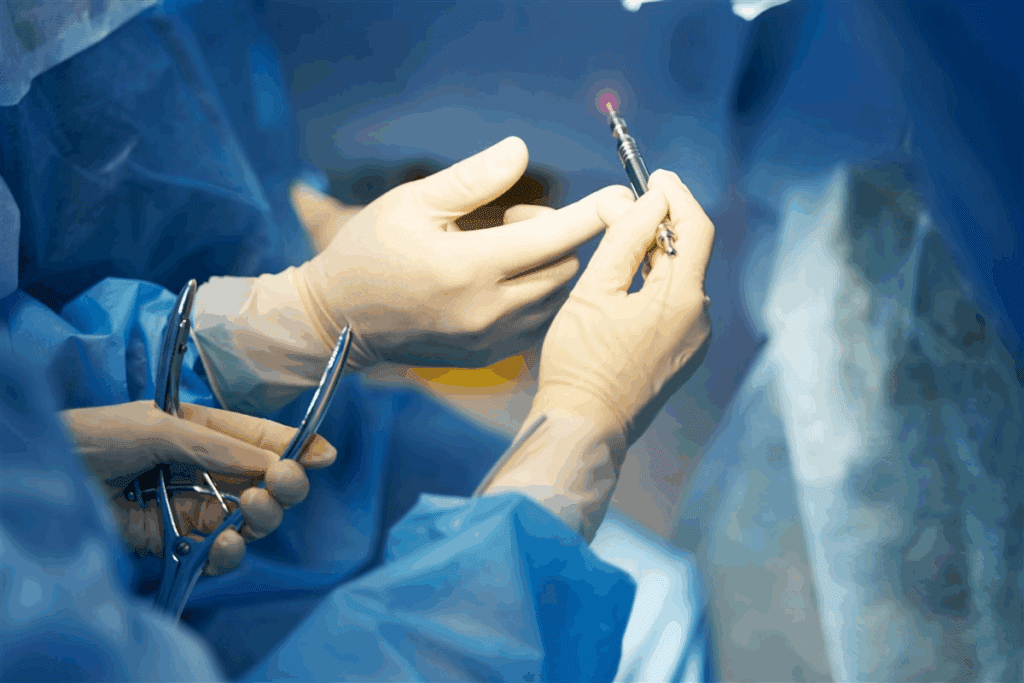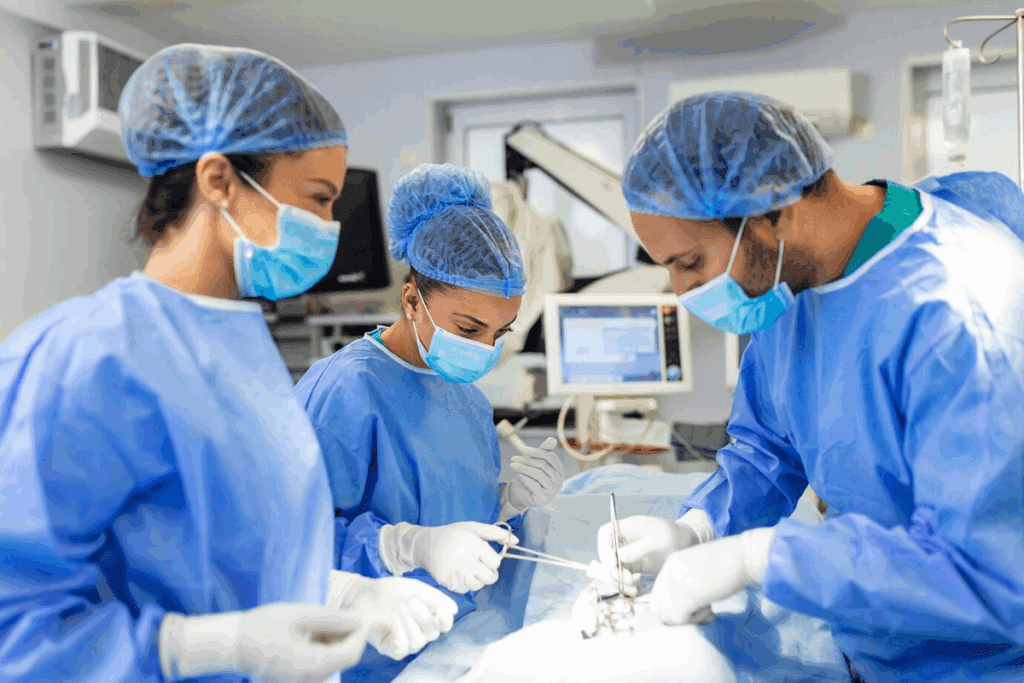Last Updated on October 30, 2025 by Saadet Demir

Medical technology has changed how we treat illnesses. Non invasive surgery is becoming more common because it offers easier, faster recovery and fewer risks compared to traditional operations.
At Liv Hospital, we focus on advanced treatments that don’t require large cuts or long hospital stays. Our expert team uses the latest technology to provide non invasive surgery options that are both safe and effective.
Understanding the difference between invasive and non invasive treatments helps patients make informed choices about their care. With our patient-centered approach and modern medical methods, you can trust Liv Hospital to deliver the highest standard of healthcare.

Understanding non-invasive surgery is key to seeing its role in today’s medicine. It means medical procedures that don’t need big cuts or harm the body much.
Healthcare is moving towards non-invasive treatments fast. This change comes from new tech and people wanting safer, easier options. It’s changing how we treat medical issues, giving patients more choices and better results.
At its heart, non-invasive surgery uses imaging and outside devices to treat conditions without going inside the body. It aims to cause less harm, speed up recovery, and cut down on risks.
Key principles include:
The history of non-invasive techniques has seen fast growth. It started with X-rays for diagnosis and now includes advanced tools like MRI and CT scans.
Technological milestones include:
| Year | Technological Advancement | Impact on Non-Invasive Surgery |
| 1895 | Discovery of X-rays | Enabled diagnostic imaging without surgery |
| 1970s | Introduction of CT scans | Improved diagnostic accuracy and detail |
| 1980s | Development of MRI technology | Allowed for detailed soft tissue imaging |
As tech keeps improving, non-invasive surgery will get even better. It will bring hope to patients all over the world.

The medical field has many interventions, from non-invasive to invasive surgeries. It’s key for patients to understand these options to make good choices about their health.
Non-invasive procedures don’t need cuts or tools inside the body. They use new tech, like imaging, to help diagnose and treat. Examples include imaging-guided treatments and energy-based therapies, which are less harmful and heal fast.
These procedures have big benefits. They lower the risk of problems, cause less pain, and have shorter recovery times. We’ll look into these benefits more later.
Minimally invasive techniques, like laparoscopic surgery, use small cuts and new tech for precise work. They cause less damage and heal faster than old surgeries.
Minimally invasive surgery (MIS) has changed the medical world. It’s a bridge between non-invasive and old surgeries. MIS uses special tools and cameras through small cuts, causing less harm to patients.
Traditional invasive surgeries need big cuts for direct access. They are more invasive and take longer to recover. But, they’re sometimes needed for serious or complex cases.
Choosing traditional surgery is often after trying other options. We’ll talk about what makes this choice later.
Non-invasive surgery is very versatile and used in many medical fields. We will look at the different types of non-invasive surgeries and their roles in today’s medicine.
Imaging-guided interventions use advanced imaging to guide surgeries. This makes them more precise and safer. Tools like ultrasound, MRI, and CT scans help doctors see where they are working.
For example, in heart problems, these methods help place stents accurately. This improves treatment results and cuts down recovery time.
Radiation treatments use high-energy to kill cancer cells and diseased tissues. Stereotactic body radiation therapy (SBRT) and stereotactic radiosurgery (SRS) are types of non-invasive radiation treatments. They deliver precise radiation to specific areas.
These treatments are very effective for some cancers. They are a key part of cancer treatment. They also protect healthy tissues, making them safer than old methods.
Energy-based therapies use energy like laser, radiofrequency, or ultrasound for treatment. They don’t need surgery. These therapies are used for both cosmetic and medical treatments.
| Therapy Type | Application | Benefits |
| Laser Therapy | Skin rejuvenation, tattoo removal | Minimally invasive, quick recovery |
| Radiofrequency Therapy | Skin tightening, body contouring | Non-surgical, reduced risk of complications |
| Ultrasound Therapy | Tissue ablation, physical therapy | Non-invasive, precise targeting |
Understanding non-invasive surgeries and their uses shows their big benefits in today’s medicine.
It’s important to know about common invasive surgical methods. They are key in modern medicine but come with risks and long recovery times. These surgeries are used for many health issues.
Open surgery means making a big cut to reach the problem area. It lets surgeons see and work on the area directly. This method is used for big operations like organ transplants.
But, open surgery has downsides. It means longer healing times, more chance of infection, and more pain than smaller surgeries.
Endoscopic and laparoscopic surgeries are less invasive. They use small cuts for a camera and tools. This way, surgeons can see the inside of the body on a screen.
Laparoscopic surgery is often used for gallbladder removal and hernia repair. It causes less damage, less pain, and faster healing than open surgery.
Robotic-assisted surgery is a new tech that helps surgeons be more precise. It uses a robotic system to make small movements inside the body.
This method is used for many surgeries, like prostate and heart valve repairs. It leads to less blood loss, smaller cuts, and quicker healing.
To understand the differences between these surgeries, let’s look at a comparison.
| Surgical Approach | Incision Size | Recovery Time | Pain Level |
| Open Surgery | Large | Long | High |
| Laparoscopic Surgery | Small | Moderate | Moderate |
| Robotic-Assisted Surgery | Minimal | Short | Low |
By comparing these surgeries, we see they are effective but differ in recovery, pain, and cut size. Knowing these differences helps patients and doctors choose the best surgery.
Understanding non-invasive surgery’s benefits helps patients choose wisely. It’s a top choice for many medical needs because of its advantages.
Non-invasive surgery means less time to heal. It causes less harm to the body, so patients heal faster. This is great for those with busy lives or who can’t afford to be out of action for long.
Faster recovery also means shorter hospital stays. This lowers the chance of getting sick from the hospital and other complications from staying too long.
Non-invasive surgery aims to reduce pain and discomfort. It avoids big cuts and less damage to tissues, leading to less pain after. This makes recovery easier and cuts down on the need for pain meds.
“The advancements in non-invasive surgery have significantly improved patient comfort and reduced the need for post-operative pain management.”
Non-invasive surgery has fewer risks than traditional surgery. It causes less damage, lowering the chance of infections, bleeding, and other issues. This makes it safer for those at high risk for surgery problems.
Non-invasive surgery is often cheaper than traditional surgery. It saves on hospital costs, recovery time, and fewer complications. Plus, it can be done on an outpatient basis, reaching more people.
We think non-invasive surgery’s cost savings and benefits make it a great choice for quality medical care.
Non-invasive surgery has changed medical treatments a lot. But, it’s not perfect. Knowing its limits helps us make treatments better for patients.
Non-invasive treatments work well for some things, like beauty treatments or small fixes. But, they can’t handle serious or complex problems as well.
For example, non-invasive radiation therapy might not work as well for some cancers. This shows why knowing its limits is important for doctors to talk to patients right.
The success of non-invasive treatments depends a lot on new technology. But, this also brings problems:
| Technology | Challenge | Potential Solution |
| Imaging Systems | High Maintenance Costs | Regular Maintenance Scheduling |
| Energy-Based Devices | Limited Availability | Increased Investment in Healthcare Infrastructure |
Not every patient is right for non-invasive treatments. Choosing the right patients is key for good results. We need to think about:
By looking at these things, doctors can decide if non-invasive treatments are good for each patient.
Non-invasive procedures have changed the medical world. They offer effective treatments with little harm. This shift is thanks to new non-invasive methods.
These methods are used in many medical fields. They give patients safer choices than old surgeries. Benefits include shorter recovery times, less pain, and fewer complications.
Cardiovascular treatments have gotten better. Now, we can diagnose and treat heart issues without surgery. Echocardiography and cardiac MRI let us see the heart clearly. Treatments like TAVR fix valves without big surgery.
These new ways have made patients better and cut down on big surgeries. For example, TAVR works well for aortic stenosis. This is when the aortic valve gets too narrow, blocking blood flow.
In neurology, non-invasive methods help diagnose and treat many issues. TMS and tDCS are being studied for treating depression and Parkinson’s. They might help with other brain problems too.
These brain treatments seem to work well with few side effects. They offer hope for people with hard-to-treat conditions.
Non-invasive methods are also used for bone and muscle problems. Shockwave therapy and PRP therapy help tendons and ligaments heal. This means fewer surgeries are needed.
These treatments are great for athletes and those with sports injuries. They help people get back to their activities faster with less rest.
More people are choosing non-invasive options for beauty. These choices are safer than surgery. They promise quick recovery and little downtime, perfect for those wanting beauty without surgery’s risks.
Skin rejuvenation is key in non-invasive beauty treatments. These methods aim to make skin look better, fighting aging signs and boosting health. Laser treatments and chemical peels are top choices. They boost collagen, smooth out lines, and improve texture.
Microdermabrasion is another favorite. It’s a gentle exfoliation that brightens and smooths the skin. It’s fast, almost painless, and you can go back to your day right after.
Body contouring reshapes the body without surgery. Cryolipolysis and radiofrequency treatments are leading methods. They target fat cells, slimming down and shaping the body.
These options are great because they’re a safer, non-surgical alternative to liposuction. They offer big changes with little risk and no downtime.
Facial enhancements use non-invasive methods to beautify the face. Dermal fillers and botulinum toxin injections are common. They fill in lost volume, smooth wrinkles, and highlight facial features. Though they involve injections, they’re quick and have little recovery time.
Other methods include chemical peels and laser skin resurfacing. They enhance skin texture and look. These treatments can be customized to meet individual beauty needs.
Technological advancements are changing non-invasive surgery. We’re seeing big changes in how these surgeries are done. This is all thanks to new tech in different fields.
Advanced imaging is leading the way in non-invasive surgery. These new tools help doctors see exactly where they’re working. This makes surgeries more accurate and effective.
Key Imaging Technologies:
These tools let doctors watch and adjust in real time. This improves how well patients do after surgery.
| Imaging Technology | Application in Non-Invasive Surgery | Benefits |
| MRI | Soft tissue visualization | High-resolution images without radiation |
| CT scans | Detailed cross-sectional imaging | Quick and accurate diagnosis |
| Ultrasound | Real-time imaging during procedures | No radiation, portable, and cost-effective |
Artificial Intelligence (AI) is becoming a big part of non-invasive surgery. AI can look at lots of data. This helps doctors predict how well a patient will do and plan the best treatment.
AI’s role in non-invasive surgery includes:
New energy methods are being worked on for non-invasive surgery. These include advanced lasers, high-intensity focused ultrasound (HIFU), and other energy treatments.
Benefits of Emerging Energy Modalities:
As these technologies get better, we’ll see even more effective and less invasive treatments for patients.
When thinking about surgery, it’s key to know the difference between invasive and non-invasive methods. Healthcare professionals help patients understand these options. This way, they can choose the right treatment for their health issue.
The first step is to check the patient’s health condition. We look at the condition’s type, how serious it is, and its impact on life. A detailed medical check helps decide if invasive or non-invasive surgery is better.
Some health issues need quick, invasive surgery because they’re very serious. Others can be treated with less invasive methods. We think about the patient’s health, any other health problems, and past surgeries.
Doing a risk-benefit analysis is key when choosing between invasive and non-invasive surgery. Each option has its own risks and benefits. Invasive surgeries might be more effective for serious conditions but carry higher risks and longer recovery times.
When deciding, lifestyle and recovery are important. Patients need to think about their daily life, support, and ability to follow post-surgery instructions. Recovery time and care needs can affect life during healing.
Non-invasive methods usually mean shorter recovery times and less life disruption. But, they depend on the condition and the patient’s health.
By looking at the medical condition, doing a thorough risk-benefit analysis, and thinking about lifestyle and recovery, patients can make smart choices. We support our patients at every step, making sure they get care that fits their needs.
Non-invasive surgery is changing fast, thanks to new tech and methods. This shift means patients get safer, easier, and more effective care.
New non-invasive treatments are changing how we tackle health issues. Knowing the good and bad of non-invasive surgery helps us see its big impact on healthcare.
Non-invasive treatments are getting more popular because they mean less downtime and fewer risks. As non-invasive surgery grows, we’ll see even more creative uses in medicine.
We’re excited about the future of non-invasive medicine. With ongoing progress, we’ll keep seeing big changes. Staying up-to-date with non-invasive surgery news helps everyone make better choices.
Non-invasive surgery is a type of medical treatment that doesn’t need cuts or going inside the body. It causes less harm and often means you can get back to normal faster.
Non-invasive surgery doesn’t need cuts or going inside the body. In contrast, invasive procedures do need cuts or instruments to be inserted into the body.
Non-invasive surgery has many benefits. It means less time to recover, less pain, fewer risks, and it’s often cheaper.
Some examples include treatments that use images, radiation, or energy. This includes things like skin treatments and body shaping.
No, not all medical conditions can be treated with non-invasive procedures. Doctors must carefully choose the best treatment for each patient.
Minimally invasive techniques, like laparoscopic surgery, use small cuts and technology to cause less damage. Non-invasive procedures don’t need cuts or going inside the body at all.
Technology is key in non-invasive surgery. New imaging, AI, and energy technologies make these treatments more precise and effective.
To decide, think about your health, the risks and benefits, and how you’ll recover. Talking to a doctor can help you make the best choice.
Non-invasive treatments have some limits. They might not work for everyone, and there can be technology and patient selection challenges. These need careful consideration.
Yes, non-invasive surgery can be used for beauty and cosmetic reasons. This includes treatments for the skin, body, and face.
The future of non-invasive surgery looks bright. New tech and techniques will make these treatments even better and more useful in medicine.
Subscribe to our e-newsletter to stay informed about the latest innovations in the world of health and exclusive offers!
WhatsApp us